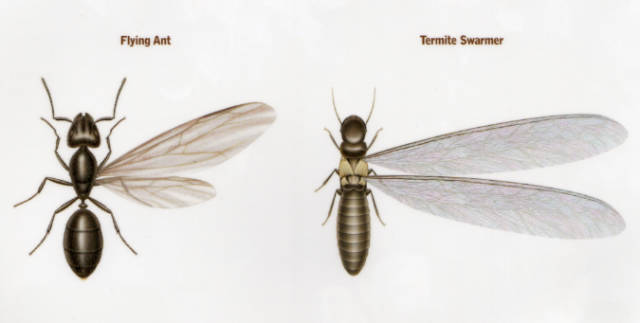Carpenter ants, which are known for destroying wood, are not just annoying bugs that run around our houses. These interesting insects have a very interesting life cycle, and one of the most interesting parts is when “swarmers,” which are people with wings, appear. In this piece, we’ll learn about the world of carpenter ants with wings and find out how important their wings are when they’re reproducing.
Identifying Carpenter Ant Swarmers: Carpenter ant swarmers are the colony’s reproducers. They are different from most working ants in a few ways. First of all, swarmers are bigger—they are between 6 and 13 mm long. Most worker ants are black, but swarmers can be a mix of black and red, or they can be completely red or brown. But the most noticeable thing about them is that they have two sets of wings, which makes them easy to spot when it’s time for them to mate.
The Mating Season: Carpenter ants have a mating season that changes based on where they live and the weather. In warmer places, it usually happens in the spring, but in cooler places, it can happen in the early summer. During this time, adult colonies make both male and female reproductive ants with wings so they can fly off to find a mate.
Nuptial Flight: Carpenter ants’ nuptial flight is a fascinating part of their lives. When it’s hot and muggy, usually after it’s rained, the winged ants take to the air to find mates in nearby colonies. The carpenter ant swarmers go on this exciting trip because they have a strong urge to have babies.
4. Mating and Going Their Separate Ways: Mating takes place during the nuptial flight. Male and female carpenter ants perform a mating routine in the air as a way to show their love for each other. The males die soon after mating, while the females that have been bred lose their wings. These female ants that don’t have wings are now called “queen ants.” After completing their task, they leave to find a good place to nest so they can start new colonies.
5. Starting a New Colony: The newly-mated queen ants spend a lot of time looking for a good place to start a new colony. They look for places with enough wetness and decaying wood because these are the best places to start their colonies. Queen ants use their strong jaws to make holes in the wood where they will build their nests and lay their first batch of eggs.
6. The development of the queen ant and the worker ants: Once the eggs are laid, the queen ant takes good care of them until the babies hatch. As the larvae pupate, they change into adult worker ants through a process called metamorphosis. These hardworking worker ants become the heart of the new colony. They do things like find food, care for the young, and make the nest bigger.
7. The Colony Grows: When a new colony is set up, there are only a few worker ants, but over time, the colony grows very quickly. As the worker ants keep adding to the nest and the queen keeps laying eggs, the number of ants in the colony grows slowly. If the conditions are right, a carpenter ant community can grow to have thousands of members.
8.Satellite Colonies: Carpenter ant nests often produce satellite nests. These smaller nests are connected to the main nest and are generally close to it. When carpenter ants have satellite colonies, they can look for food in different places. This makes it harder to completely get rid of an invasion.
In conclusion, knowing how carpenter ants with wings reproduce gives a fascinating look into their complex life cycle and behaviour. The nuptial flight is an important event that makes it easier for birds to mate and start new groups. By knowing what carpenter ant swarmers look like and how they act, homeowners can catch swarms early and take steps to stop the ant population from growing in their homes. For effective management and removal of carpenter ant colonies, it is best to hire a professional pest control service. This will make sure that our homes stay free of these interesting but possibly harmful insects.



